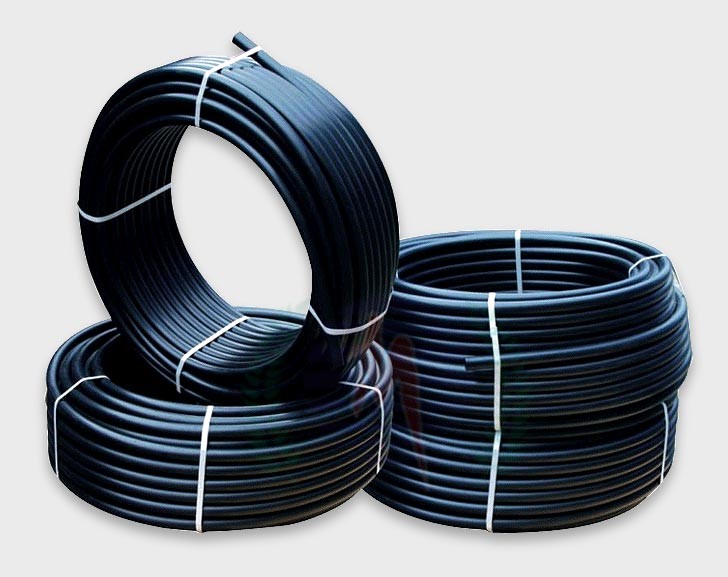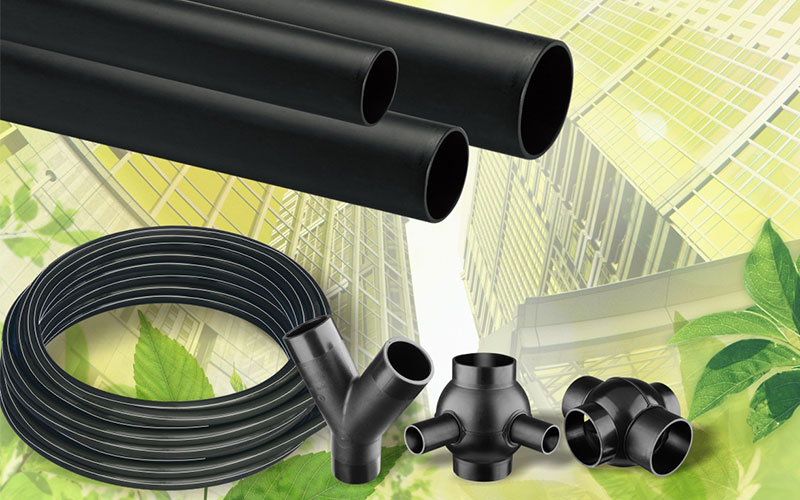Key Insights of custom hdpe pipe manufacturing Midland TX for Specialized Industries
Wiki Article
Check Out the Manufacturing Refine Behind High-Quality HDPE Pipe and Its Applications
The manufacturing procedure of high-grade HDPE pipelines is complex and methodical. It begins with the selection of resources that boost performance. Following this, ethylene undergoes polymerization to create material, which is after that shaped with extrusion. Quality assurance is extremely important, guaranteeing that the final product meets stringent requirements. Nevertheless, the journey of HDPE pipes doesn't end with manufacturing. Their applications across various sectors reveal a broader value worth checking out.Comprehending HDPE: Residences and Advantages

High-density polyethylene (HDPE) is a flexible thermoplastic known for its sturdiness and resistance to various environmental variables. This product displays outstanding tensile toughness, making it suitable for requiring applications. Its low-density structure adds to a lightweight product, helping with simplicity of managing and setup. HDPE likewise showcases exceptional resistance to chemicals, which minimizes degradation when exposed to harsh substances.
The material's low wetness absorption better boosts its long life, making it ideal for usage in pipes and tank. In addition, HDPE is immune to ultraviolet (UV) radiation, making sure that items maintain their integrity also when subjected to sunlight. Furthermore, its flexibility permits the creation of complex forms without jeopardizing toughness. The environment-friendly nature of HDPE, typically originated from recycled materials, includes in its appeal, advertising lasting techniques in manufacturing. On the whole, these homes and benefits make HDPE a recommended option for different commercial and customer applications.
Basic Material Selection for HDPE Production
The choice of basic materials for HDPE manufacturing is vital to confirm the final product meets the preferred specs and quality requirements. High-density polyethylene (HDPE) is primarily generated from polymerized ethylene, originated from fossil fuels such as all-natural gas or unrefined oil. The top quality of these feedstocks significantly affects the mechanical and thermal residential or commercial properties of the final HDPE.Ingredients additionally play a considerable duty in boosting HDPE's performance, consisting of anti-oxidants, UV stabilizers, and colorants, which boost sturdiness and resistance to ecological elements. The choice process have to think about not only the chemical make-up of the raw materials but likewise their processing characteristics to guarantee effective production.
The sourcing of raw materials need to prioritize sustainability and conformity with ecological regulations, as liable methods are essential in today's market. Eventually, cautious resources selection lays the foundation for generating high-grade HDPE pipes appropriate for varied applications.
The Extrusion Process: Shaping HDPE Pipeline
The extrusion procedure plays an essential function in forming HDPE pipes, beginning with precise product prep work techniques that assure perfect circulation and uniformity. Just as vital is the style of the die, which straight affects the final measurements and surface area quality of the pipeline. Together, these variables add significantly to the efficiency and quality of HDPE pipeline production.Product Prep Work Strategies
Effective manufacturing of HDPE pipes starts with meticulous material preparation methods, particularly the extrusion process. During this stage, high-density polyethylene material is very first dried to remove dampness, ensuring suitable circulation characteristics. The material is then fed right into the extruder, where it undertakes home heating and melting, transforming into a viscous state. This home heating process is meticulously regulated to maintain the product's integrity and performance. The liquified HDPE is compelled via a die, shaping it into a continuous pipe form. Proper temperature administration during extrusion is vital, as it straight impacts the product's homes and the final item top quality. Once shaped, the HDPE pipe is cooled down and cut to defined sizes, prepared for succeeding processing and applications.Die Layout Importance
Accuracy in die layout plays a necessary role in the extrusion process of HDPE pipes. The die works as the final shaping device, straight affecting the pipe's measurements, wall density, and surface coating. A well-designed die warranties consistent material flow, minimizing flaws such as irregularities and weak points. The geometry of the die should be maximized to basics suit the certain properties of HDPE, including its thickness and thermal behavior throughout extrusion. In addition, the cooling price of the product as it passes with the die can noticeably affect the pipeline's structural integrity. As a result, buying advanced die innovation is important for makers intending to produce high-grade HDPE pipes that meet market criteria and customer expectations.Quality Assurance Measures in HDPE Manufacturing
Although various variables influence the high quality of HDPE pipe production, reliable quality assurance steps are essential to guarantee consistency and integrity in the final item. Trick quality assurance techniques consist of rigorous product evaluation, validating that the raw polyethylene satisfies well established criteria for purity and density. During the extrusion procedure, parameters such as temperature level, pressure, and cooling time are closely monitored to maintain dimensional accuracy and architectural honestyIn enhancement, post-production testing is crucial; makers commonly perform hydrostatic examinations to analyze the pipeline's strength and resistance to stress. Aesthetic evaluations for surface defects further improve quality control. Accreditation from appropriate requirements organizations, like ASTM or ISO, offers an extra layer of trustworthiness. By implementing these comprehensive quality assurance steps, manufacturers can reduce flaws, enhance efficiency, and make certain that the HDPE pipelines fulfill the specific requirements of various applications, inevitably causing customer satisfaction and rely on the product.
Applications of HDPE Pipeline Throughout Industries
HDPE pipelines are made use of across different fields due to their sturdiness and flexibility. In water distribution systems, they guarantee reliable delivery, while in wastewater management, they supply trusted solutions for waste transport. Furthermore, farming irrigation networks gain from HDPE's resistance to rust and adaptability, making Website it a perfect choice for contemporary farming methods.
Water Distribution Solutions
A considerable variety of markets rely upon high-density polyethylene (HDPE) pipelines for efficient water distribution systems. Known for their durability and resistance to corrosion, HDPE pipelines are widely used in municipal water supply networks, farming watering, and go to these guys industrial applications. Their light-weight nature helps with easy handling and installment, decreasing labor prices and time. In addition, HDPE pipes can accommodate various stress levels, making them suitable for both low and high-pressure systems. hdpe pipe in stock Midland TX. The flexibility of the material permits seamless integration right into existing facilities, reducing the requirement for extensive excavation. In addition, HDPE's resistance to chemical leaching assurances that the water supplied continues to be risk-free and tidy, making it an ideal option for preserving the high quality of safe and clean water across various fieldsWastewater Monitoring Solutions
Effective water circulation systems additionally pave the means for innovative wastewater administration solutions, where high-density polyethylene (HDPE) pipelines play a considerable role. Renowned for their longevity and resistance to deterioration, HDPE pipelines are excellent for carrying wastewater in numerous setups. Their versatility permits very easy setup in intricate atmospheres, lessening the need for considerable excavation. Additionally, HDPE's smooth indoor surface lowers rubbing, boosting flow rates and performance. These pipelines are likewise resistant to chemical leaching, guaranteeing that impurities do not endanger the surrounding setting. Industries, municipalities, and treatment centers increasingly count on HDPE pipes for their integrity and durability, making them a favored selection for modern wastewater administration systems. This versatility emphasizes the critical significance of HDPE pipes throughout countless applications.Agricultural Irrigation Networks
Agricultural irrigation networks profit considerably from the use of high-density polyethylene (HDPE) pipelines, which provide efficient and trustworthy water delivery to plants. HDPE pipes are light-weight, making them very easy to carry and set up, while their adaptability permits numerous configurations in varied terrains. These pipelines demonstrate superb resistance to rust, chemicals, and UV radiation, ensuring durability in extreme farming atmospheres. Furthermore, their smooth indoor surface area decreases friction loss, maximizing water circulation and reducing energy expenses connected with pumping. The long life of HDPE pipelines, usually going beyond 50 years, adds to reduce upkeep and replacement expenditures. Farmers increasingly depend on HDPE pipes to enhance irrigation effectiveness and advertise lasting farming methods, inevitably leading to enhanced crop yields and source conservation.
Future Trends in HDPE Pipe Innovation
As the need for lasting and effective infrastructure expands, advancements in HDPE pipeline innovation are poised to transform different markets. Arising fads include the assimilation of smart modern technologies, such as sensing units and IoT abilities, which help with real-time tracking of pipeline conditions, decreasing maintenance costs and stopping leakages. Furthermore, the development of sophisticated production strategies, such as 3D printing, is allowing the production of complicated, customized pipeline styles that satisfy particular project requirements.The emphasis on recycling and circular economic climate methods is driving the technology of HDPE pipelines made from recycled materials, boosting sustainability. Improved jointing methods, such as electro-fusion and mechanical fittings, are also boosting installment effectiveness and reliability. The expanding emphasis on environmental regulations is pushing manufacturers to adopt greener production procedures, ensuring that HDPE pipes not just fulfill industry criteria yet likewise foster a more sustainable future for framework advancement.
Regularly Asked Questions
Exactly How Does HDPE Contrast to Other Plastic Products?
HDPE outmatches several other plastic materials relating to longevity, chemical resistance, and versatility. Its low density and high tensile toughness make it perfect for various applications, usually exceeding alternatives in both efficiency and durability.What Are the Environmental Effects of HDPE Production?
The environmental impacts of HDPE production consist of greenhouse gas emissions, power usage, and possible contamination from producing procedures. Furthermore, incorrect disposal can lead to soil and water contamination, increasing issues concerning long-term ecological effects.Can HDPE Pipes Be Recycled?
Yes, HDPE pipelines can be recycled. Several centers approve used HDPE for processing, transforming it into new products. This reusing contributes to sustainability initiatives, lowering plastic waste while conserving sources and energy in the production cycle.What Is the Life-span of HDPE Pipeline?

Exactly How Do Temperature Level Variants Affect HDPE Pipe Performance?
Temperature level variants significantly affect HDPE pipeline efficiency, influencing adaptability and stamina. Heats can cause softening, while reduced temperatures may cause brittleness, eventually influencing the pipe's sturdiness and viability for different applications in varied environments.Report this wiki page